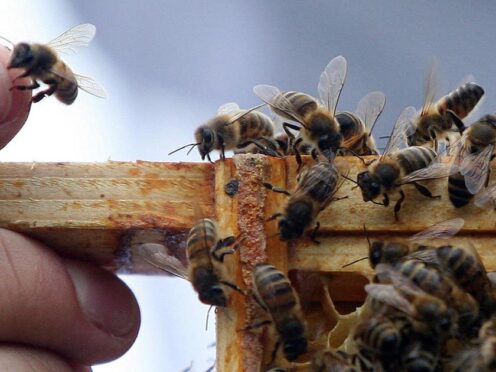
Tapping gently on a hive and and listening to the bees’ collective response can reveal the health of a honeybee colony without needing to look inside, scientists say.
Researchers have found that bees react in unison to soft vibrations on their hives with “positive” buzzing noises.
The team fitted gadgets on eight hives at an apiary in Nottinghamshire to generate short and gentle shakes – simulating the vibrations of a tap.
The honeybees’ responses were recorded using another device inside the hive, known as the accelerometer.
In the summer months, when bees were busy looking for food, caring for their young and maintaining the hive, they paid little attention to the vibrations, according to the team.
However, the insects were found to be more sensitive to the vibrations during winter, when they were less active.
The researchers said this is important because bees pause foraging for many weeks during winter, so from outside, it is not possible to tell if the colony is dead or alive.
While beekeepers can inspect hives by opening them, the scientists said this is invasive and can harm the colony.
Lead researcher Dr Martin Bencsik, a scientist in Nottingham Trent University’s School of Science and Technology, said: “It’s a bit like a bear that falls asleep for the winter, sometimes you cannot tell if the animal is alive or not.
“A gentle tap, causing a tiny, but measurable reaction, will reveal whether the animal is in its normal state or not.”
There are 600 professional and 25,000 registered amateur beekeepers in the UK, the researchers say.
Dr Bencsik said that in winter, some beekeepers knock on their beehives with their hand to listen for a buzzing response, but “until now, the potential relevance of this simple test had never been looked into carefully”.
The researchers said their study, published in the journal Scientific Reports, is also the first to show a collective “reflex arc” in invertebrates, where a group automatically and unconsciously responds to a stimulus.
Dr Bencsik added: “Our pioneering method also allows us to test for mobility, revealing another aspect of the health and physiological status of the colony inside the hive.”
He said this non-invasive method can also detect whether the colony is queenless – which can have serious consequences for the hive’s survival.
The researchers said they also picked up on a few individual bees making “whooping” noises – which the insects are thought to produce when startled.
Dr Bencsik said: “We believe our work might also help to give beekeepers an indication of the size of their colonies.”
The researchers said as part of the next steps, they are going to trial the method with beekeepers in the UK, in Belgium, in Norway, Holland and Romania.

Enjoy the convenience of having The Sunday Post delivered as a digital ePaper straight to your smartphone, tablet or computer.
Subscribe for only £5.49 a month and enjoy all the benefits of the printed paper as a digital replica.
Subscribe